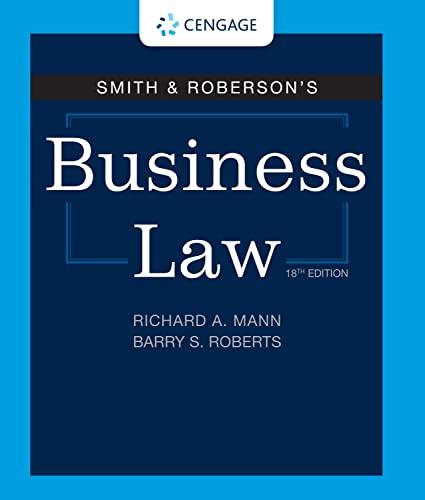Question
Smith v. Goguen (1974) On January 30, 1970 two police officers in Leominster, Massachusetts observed teenager Valeria Goguen to be wearing a United States flag
Smith v. Goguen (1974)
On January 30, 1970 two police officers in Leominster, Massachusetts observed teenager Valeria Goguen to be wearing a United States flag patch on the back left pocket of his pants. On January 31, one of the officers swore out a complaint against Goguen under the Massachusetts flag-misuse statute. The statute stated in part:
"Whoever publicly mutilates, tramples upon, defaces or treats contemptuously the flag of the United States.... whether such flag is public or private property..., shall be punished by a fine of not less than ten nor more than one hundred dollars or by imprisonment for not more than one year, or both...."
Goguen was convicted under the contempt provision.
However, Goguen's conviction was overturned by the Supreme Court when the Massachusetts statute was found to be unconstitutionally vague. Nonetheless, several justices argued that flag desecration statutes could be constitutional if they were well-written. Here is Mr. Justice White, concurring in the judgment:
"I would not question those statutes which proscribe mutilation, defacement, or burning of the flag or which otherwise protect its physical integrity, without regard to whether such conduct might provoke violence. Neither would I find it beyond congressional power, or that of state legislatures, to forbid attaching to or putting on the flag any words, symbols, or advertisements. All of these objects, whatever their nature, are foreign to the flag, change its physical character, and interfere with its design and function. There would seem to be little question about the power of Congress to forbid the mutilation of the Lincoln Memorial or to prevent overlaying it with words or other objects. The flag is itself a monument, subject to similar protection."
Justice White's reasoning is that the American flag is similar to the Lincoln Memorial in certain respects. Congress could pass a law to forbid desecration of the Lincoln Memorial; therefore--by analogy--Congress could pass a law to forbid desecration of the American flag.
Instructions
- Construct a formal argument by analogy to the conclusion that the flag should receive similar protection as the Lincoln Memorial.
- Then critique that argument.
To build the Argument by Analogy that Justice White uses, follow these steps:
- Identify three properties that the Lincoln Memorial andthe American Flag have in common. (Note: This will require a bit of thinking. Justice White says that the flag is a monument--and the Lincoln Memorial is clearly a monument too--but finding other similarities requires thinking about the objects and their place in our society.)
- Use those properties to build premises 1 and 2 in a formal argument by analogy.
- Use "Congress has the power to forbid the mutilation of the Lincoln Memorial" as premise 3 of the argument.
- Build the conclusion of the argument in a way that parallels premise 3, but that refers to the American flag rather than to the Lincoln Memorial.
The strongest objection to an argument by analogy is citing an important difference between the two things that are being compared. In fact, a single relevant difference can be a powerful counterargument to an argument by analogy. So to critique Justice White's argument:
- Identify an important difference between the Lincoln Memorial and the American flag.
When you complete the assignment, you may submit it either via text entry or by uploading a docx word document.
Step by Step Solution
There are 3 Steps involved in it
Step: 1

Get Instant Access to Expert-Tailored Solutions
See step-by-step solutions with expert insights and AI powered tools for academic success
Step: 2

Step: 3

Ace Your Homework with AI
Get the answers you need in no time with our AI-driven, step-by-step assistance
Get Started


